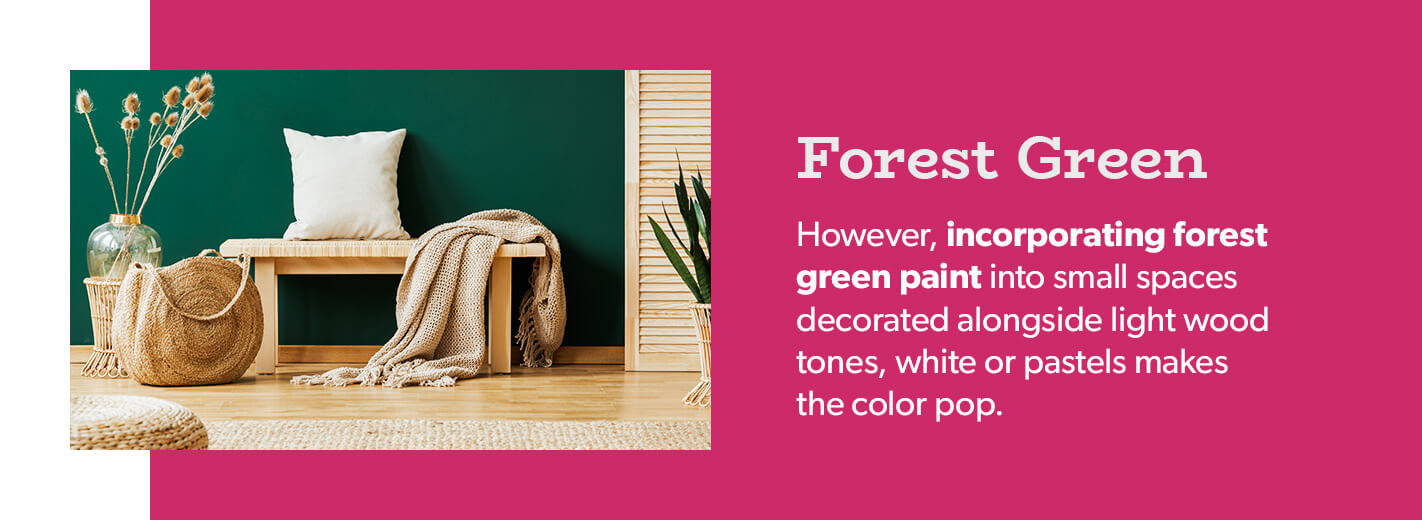Painting small rooms like bathrooms, laundry rooms and closets can require more work than you think. Enhance your small room like a professional by using these simple paint techniques and color schemes.
How to Paint a Small Room
Working with narrow angles and getting the perfect brushstrokes without accidentally painting your closest cabinets can be challenging. Fortunately, there are many ways to streamline painting small rooms. Here are some tips to get you started.
Get All the Equipment
Painting a small room can be a more significant challenge than you expected without proper preparation. Before you start painting, get all your must-have equipment. Essential supplies include:
- Paintbrush
- Paint
- Roller
- Roller tray
- Dropcloth
- Screwdriver or paint opener
- Ladder
- Ziploc or plastic grocery bag
Tape off Corners and Lines
Use painter’s tape for sharp lines and to avoid getting paint on unwanted areas like shelving or cabinetry. Tearing your tape into strips will help you get a straight line and is more manageable than running your tape from one end to the other.
Use a Paint Roller
Put down the brush and extension, climb your ladder and get rolling for efficient painting. Paint rollers work well in small rooms, especially in conjunction with painter’s tape. Since roller extensions can be challenging to use in small spaces, remember you can paint your small room just as well with your regular roller and a ladder.

Preserve Your Brush and Roller
After using your brush and roller, secure them in a Ziploc or plastic shopping bag. These are excellent solutions for keeping your brush and rollers from drying out while waiting for your first coat to set or attending to family or other errands.
Paint Edges After the First Coat
Your first paint coat can take longer to dry in a small room. To save time, start cutting in your edges with a paintbrush, even if the first coat hasn’t dried yet.
Try Light Colors
Whether you’re painting your laundry room or closet, using light colors and tones can enhance smaller areas. To expand your space, try paint tones like white and cream. Light color can complement a small room with natural lighting, making your space look more prominent.
Use High-Quality Paint
Walls in small rooms can show signs of wear and tear over time. Think about how often you might bump the laundry room wall with your ironing board or scuff your closet when you kick off your shoes. Using high-quality, durable paint with an eggshell finish can help repel marks and protect your wall color for longer.
Paint in One Day
Small rooms can take longer than you expected to dry, especially if you use two coats. Working around wet paint walls can be challenging in a space you use daily, like a laundry room or utility closet. Try painting your small room in one day and avoid tiptoeing around.
How to Make a Small Room Look Bigger With Paint
Small rooms have excellent potential, and you can illuminate your space with some creativity. Here are some ways to make a small room look larger with paint.
Try an Accent Wall
If you’re uncomfortable using dark colors throughout the room, applying them to an accent wall is an excellent alternative. It’s possible to use dark colors in a small space to create drama and interest without it becoming too overwhelming. Painting accent walls using dark colors means those shades recede into the background. In doing so, the room looks larger visually.
Use Bold Colors
An excellent way to approach accent walls is to contrast colors and tones. Avoid colors like red, orange or bright yellow. Instead of creating an illusion of space, these colors make the room feel small. Instead, choose tones like blue, green or purple. These recede from the viewer, creating an illusion of space.
Choose Light Colors
Light colors can brighten your room and enlarge your space. Accent your room’s natural light with off-white, opaque, light blue or cream tones to enhance your space. Using one color consistently throughout the room can also create flow and allow the eye to travel easily around.
Choose a Floor Color
Even though we’re concentrating on dark tones for the walls, contrasting that with light flooring creates the illusion of a spacious room.
Another consideration is choosing wood panels and installing them on the lengthiest part of the room’s dimension. Adding a gloss finish helps brighten up the space that much more. Avoid choosing dark colors for floor paint or rugs. Otherwise, the color could drag the room down.
Paint the Ceiling
A light ceiling color can give your room more depth, making it look higher. Enhance your small space with shades like light blue or gray.
Lighten up Your Room
Natural light is excellent for expanding a small space. Pick color tones for your curtains or blinds to allow natural light into your room. Lighting fixtures can also help enhance the space in rooms with little natural light.
Clutter-Free
Keep your décor simple and spare to avoid the distraction of clutter.
Connect Space With Color
Using white or pastels when painting small rooms can enhance the space. You can also use creative color palettes and accents to give your small room enormous potential. Light tones help brighten the room and make it appear more expansive. You can also use darker tones when painting small rooms. Using dark shades gives the space interest because the paint’s tone changes with the light.
Similar colors and tones can create harmony and flow throughout your home. Pair your small room with matching shades and tones to expand your space. For instance, you can match cream curtains with white bedding and off-white artwork for continuity.
Best Paint Colors for Small Rooms
Despite your efforts to make a small room feel spacious, it might still seem claustrophobic. Break free from that “closed-in” feeling using dark paint options. Here are some small room paint ideas.
Dark or Navy Blue
Make a statement with dark or navy blue paint, which helps blur the lines in small room corners. Coupling this color with bright or light tones creates impact. The result is a bold choice that distracts the eye from the smallness of the space.
Forest Green
We typically see this color as an accent on everything from dining sets to headboards. However, incorporating forest green paint into small spaces decorated alongside light wood tones, white or pastels makes the color pop.

Gray
While it might seem gray could make a room feel cavernous, that’s not the case. Choosing a dark shade like gunmetal gray gives the room a modern appeal without looking bland or washed out.
Muted Purple
Adding a subdued shade of purple to a small space highlights the color’s brown undertones. The paint creates a warm and sophisticated feel without feeling overdone if you use it in a room with additional square footage.
Personalize Any Space With Rent Painters
When decorating a small room, you might get overwhelmed thinking about what paint colors to use. Our team of experts has nearly 20 years of experience helping property owners express their personalities with paint. We will combine your vision with our professional expertise to enhance your room’s potential.
We offer an easy, streamlined process with honest cost estimates and a complete satisfaction guarantee. Use our online estimate calculator to get started.
Updated: 6/6/23
